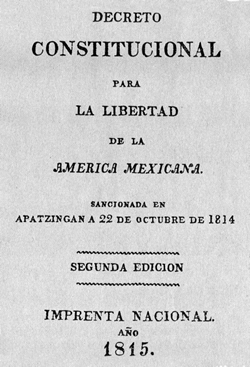
While everyday indigenous peasants grew tired of injustice, Father Miguel Hidalgo’s plea for autonomy from peninsulares would set off a chain of events that would inevitably lead to Mexican Independence. While his cries were not necessarily about independence itself, this is one of the earliest signs of rebellion. His use of Virgin of Guadalupe’s image resonated with many of the poor rural people in Mexico, and this soon became a battle of “us” vs “them” among peninsulares and those living in modern day Mexico. Miguel Hidalgo would later be captured, executed, and his severed head would be shown to the public to be made an example of. Despite the execution of Miguel Hidalgo, the seed of revolution had been deeply planted in his followers. Father José María Morelos, a mestizo priest, carried the torch after Hidalgo’s death. Morelos cast an even wider net and his goals were clear: end slavery, erradicate the caste system, and put an end to the tribute paid by indigenous peoples.
In 1813, Morelos and his followers formally created the Congress of Anáhuac, the first independent congress and they officially declared independence from Spain. They ratified the first national constitution. On October 22, 1814, the Congress promulgated the Decreto Constitucional para la Libertad de la América Mexicana. The constitution introduced ideas that resembled classical liberalism, as they emphasized the importance of certain civil liberties not granted by the Spanish Crown. Under this constitution, everyone born in Mexican soil would be considered an “Americano”. The constitution also created legislative, executive, and judicial branches of government for their new independent state. The Congress established a strong parliament and weak central government.
Unfortunately, Morelos and his Congress would never see Mexico’s independence. In 1815, Morelos would be caught and executed.
This constitution would never take hold in Mexico, but this constitution serves as evidence of deeply entrenched feelings of animosity towards foreign rulers. In the first 10 articles of this constitutions, it lays out the demands of the people to be recognized of their own state. This piece is important in colonial history and Latin American history because up until this point in time, Mexico had remained Spain’s most profitable colony. This piece juxtaposes ideas of classical liberalism, nativism, and the idea of a new state despite the tight Spanish control.
WORKS CITED:
Chasteen, John Charles. Born in Blood and Fire. 4rd edition. New York: W.W. Norton, 2016.
“Declaración Decreto constitucional para la libertad de la América mexicana, sancionado en Apatzingan á 22 de Octubre de 1814” (in Spanish).
M. Delgado de Cantú Gloria. Historia De México: Legado histórico y Pasado Reciente. México: Pearson Educación, 2008.
(Decreto Constitucional para la libertad de la América Mexicana, sancionado en Apatzingán a 22 de Octubre de 1814), Alicante: Biblioteca Virtual Miguel de Cervantes, 2014
